The last few days there has been nothing worth looking at during the night. Plenty of overcast, rain, wind etc.
So I've spent the time spending money instead. I've got a camera adapter together with a mounting ring for a Canon camera so I can turn the whole telescope into a huge camera lens. I'm still waiting for my camera to arrive, but the adapters are here. The adapter has another use in that you can also use it to mount lenses in, so as well as looking down with one lens, you can look straight through with another. This will be helpful for keeping the target in the right place. There is a mirror that flips up and down to divert the light to the normal viewing position or straight through.
Meanwhile, I'm looking into getting a better pair of binoculars - ones with a larger objective lens for better night viewing.
So not much progress basically.
Thursday 31 January 2008
Friday 25 January 2008
A clear night at last
As I sat in the office during the day, I kept sneaking a look out of the window, and there was a fair degree of blue sky visible. There were a few clouds around, but not the solid overcast that has been so common the last few weeks. I didn't dare to hope...
On the drive home, I tried squinting at the sky, to see if I could see stars. Its not very easy though, as you are speeding along to try and glimpse them amongst the street lights and tail lights.
When I jumped out of the car though, it was clear that there were stars visible, and I rushed inside, and took the telescope outside immediately to start cooling down. There seems to be quite a lot of equipment to get carried out to get set up properly. Telescope, battery power tank, hand controller, selection of lenses, table, laptop, power cable for laptop, CCD camera, digital camera, star chart...
Anyway - in between grabbing some bites for tea, and not helping get the children into bed, and loosing the mains adapter, I managed to get all set up. I aligned the telescope, and then jumped to Mars as a first test. I wanted to try out some new ideas with the LPI camera and see what I could do. Unfortunately, Mars is now almost overhead, and the telescope doesn't like such objects quite as much. First its a little harder to see in that position - and the flexible focusing adapter is bent into a 90° angle. Another problem is with the Alt-Az mounting you are close to the issue of gimble lock. When looking upwards, which way is up/down and which way right/left. I'm confused, and so are the telescope motors. I know I want it to go THIS way, but its not so clear which way that is.
Anyway - I did get it on target, but I was rather disappointed with the results.
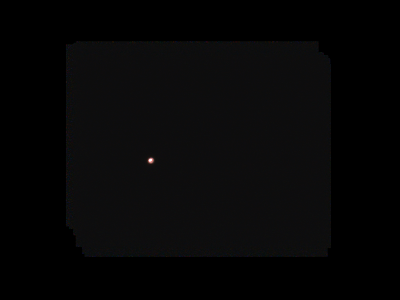
I think it is still overexposed, and clearly more work is needed.
So I waited for a while for the moon to rise. It is full at the moment, so very bright. It rose behind my increasingly least favourite tree in the neighbours garden! So I had a go at imaging that, and the results were better.

This was taken through the branches of the tree, so was subject to a bit of interference. It was about 80 images stacked together. The software has an option to save all the frames for later processing, so I took some more pictures to try processing later.
The moon was now out from behind the tree, and Saturn was very closely following it. I had a go at imaging Saturn through the tree, and managed to get some reasonable shots this time. As Saturn is very close to the moon, it is almost lost in the glow from it.

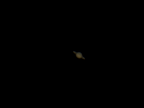
I saved the raw images again to process later. Finally, still not clear whether the LPI camera was giving better results, I took a high magnification lens, and connected the digital camera afocally to it, and took a movie of Saturn. By now I'd been outside in the cold for several hours and was running out of ideas, enthusiasm and warmth, so I wasn't as careful as I could be - it all gets a bit fiddly in the dark and concentration is hard to maintain. After processing in registax, it did look like a recognisable Saturn.

Its at a bit of an unusal angle as I had all sorts of issues getting the camera adapter aligned and connected without thumb screws running into each other.
So I took the telescope inside, and packed up. I then went and had a go at reprocessing the raw images, and the registax program is very good. It can be a bit tricky to work with, but the results were more impressive.
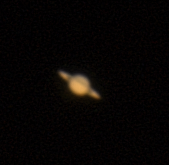


I was pleased to see some reasonable colours coming through too - perhaps I'd got the exposure better.
Finally, a quick processing of the saved moon images too for comparison.
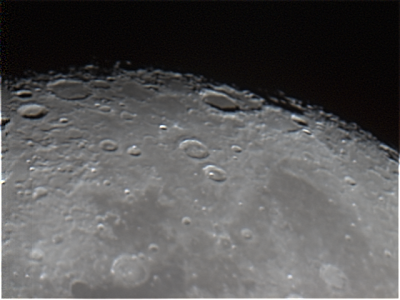
Much better! A good evenings work, I wonder when the next one will come around! Looking out the bedroom window on the way to bed, I was pleased to see in a rather selfish way, that most of the sky was now obscured by cloud. My decision to pack away was vindicated.
On the drive home, I tried squinting at the sky, to see if I could see stars. Its not very easy though, as you are speeding along to try and glimpse them amongst the street lights and tail lights.
When I jumped out of the car though, it was clear that there were stars visible, and I rushed inside, and took the telescope outside immediately to start cooling down. There seems to be quite a lot of equipment to get carried out to get set up properly. Telescope, battery power tank, hand controller, selection of lenses, table, laptop, power cable for laptop, CCD camera, digital camera, star chart...
Anyway - in between grabbing some bites for tea, and not helping get the children into bed, and loosing the mains adapter, I managed to get all set up. I aligned the telescope, and then jumped to Mars as a first test. I wanted to try out some new ideas with the LPI camera and see what I could do. Unfortunately, Mars is now almost overhead, and the telescope doesn't like such objects quite as much. First its a little harder to see in that position - and the flexible focusing adapter is bent into a 90° angle. Another problem is with the Alt-Az mounting you are close to the issue of gimble lock. When looking upwards, which way is up/down and which way right/left. I'm confused, and so are the telescope motors. I know I want it to go THIS way, but its not so clear which way that is.
Anyway - I did get it on target, but I was rather disappointed with the results.

I think it is still overexposed, and clearly more work is needed.
So I waited for a while for the moon to rise. It is full at the moment, so very bright. It rose behind my increasingly least favourite tree in the neighbours garden! So I had a go at imaging that, and the results were better.

This was taken through the branches of the tree, so was subject to a bit of interference. It was about 80 images stacked together. The software has an option to save all the frames for later processing, so I took some more pictures to try processing later.
The moon was now out from behind the tree, and Saturn was very closely following it. I had a go at imaging Saturn through the tree, and managed to get some reasonable shots this time. As Saturn is very close to the moon, it is almost lost in the glow from it.


I saved the raw images again to process later. Finally, still not clear whether the LPI camera was giving better results, I took a high magnification lens, and connected the digital camera afocally to it, and took a movie of Saturn. By now I'd been outside in the cold for several hours and was running out of ideas, enthusiasm and warmth, so I wasn't as careful as I could be - it all gets a bit fiddly in the dark and concentration is hard to maintain. After processing in registax, it did look like a recognisable Saturn.

Its at a bit of an unusal angle as I had all sorts of issues getting the camera adapter aligned and connected without thumb screws running into each other.
So I took the telescope inside, and packed up. I then went and had a go at reprocessing the raw images, and the registax program is very good. It can be a bit tricky to work with, but the results were more impressive.



I was pleased to see some reasonable colours coming through too - perhaps I'd got the exposure better.
Finally, a quick processing of the saved moon images too for comparison.

Much better! A good evenings work, I wonder when the next one will come around! Looking out the bedroom window on the way to bed, I was pleased to see in a rather selfish way, that most of the sky was now obscured by cloud. My decision to pack away was vindicated.
Wednesday 23 January 2008
A possible breakthrough
I was looking back at my attempts to focus on a CD across the garden for practice. I was struck by how much more fuzzy the LPI image was than how it looked through the telescope. I also compared some images I'd taken with the digital camera held up to the eyepiece compared with the LPI camera. I'd also found images others had taken on the web with the LPI camera, and they all looked far better than my images. OK - some of them had much better telescopes than mine, but not all of them had.
So during yet another wet day, I took a careful look at the LPI camera. There isn't that much to it really. There is a dust cap to take off, and that's it. If you look down the tube, you can just about see a small electrical chip, but there is no lens or anything.
So anyway, I wondered how the digi camera would compare with the Meade LPI, if my hunch that the digital camera was outperforming the LPI direct by some stretch.
So - another set up, focusing on the same CD. I took a short digi film through a reasonably high powered eyepiece. Then I got out the LPI again. I had another quick look at it, and wondered if there was a possibility there might be some dust or something on the CCD. Just in case I pushed one end of the lens cleaning cloth gently down the tube and gave a gentle twist just in case.
Then I fired up the laptop and got the software running. A few tweaks on the new flexible focusing knob, and I was astonished. The image was vastly better than before. There was so much detail evident I could hardly believe it. I mean - just compare the before and after:
I mean - tell that isn't at least 100% better!
I didn't even bother taking the movie off the camera for comparison. Of course now I'm itching to try this out on something celestial, but the weather is not cooperating. There was a brief patch of clear sky monday night, and I rushed to get the telescope out and set up. Even as I was carrying out though the 4 or 5 stars I could see were fading. By the time I had it ready, there was a slow drizzle which gradually got worse until it was full rain.
Sigh, this waiting lark is tough!
So during yet another wet day, I took a careful look at the LPI camera. There isn't that much to it really. There is a dust cap to take off, and that's it. If you look down the tube, you can just about see a small electrical chip, but there is no lens or anything.
So anyway, I wondered how the digi camera would compare with the Meade LPI, if my hunch that the digital camera was outperforming the LPI direct by some stretch.
So - another set up, focusing on the same CD. I took a short digi film through a reasonably high powered eyepiece. Then I got out the LPI again. I had another quick look at it, and wondered if there was a possibility there might be some dust or something on the CCD. Just in case I pushed one end of the lens cleaning cloth gently down the tube and gave a gentle twist just in case.
Then I fired up the laptop and got the software running. A few tweaks on the new flexible focusing knob, and I was astonished. The image was vastly better than before. There was so much detail evident I could hardly believe it. I mean - just compare the before and after:
I mean - tell that isn't at least 100% better!
I didn't even bother taking the movie off the camera for comparison. Of course now I'm itching to try this out on something celestial, but the weather is not cooperating. There was a brief patch of clear sky monday night, and I rushed to get the telescope out and set up. Even as I was carrying out though the 4 or 5 stars I could see were fading. By the time I had it ready, there was a slow drizzle which gradually got worse until it was full rain.
Sigh, this waiting lark is tough!
Tuesday 15 January 2008
Back on the moon
I spent a while in the afternoon practising focusing on a CD stuck to a fence post on the other side of the garden. This, after trying to focus on an advert for a shower - which written on paper had started to dissolve in the rain and had a tendency to ripple in the wind. It was rather fun to suddenly see a mostly unclothed woman jump into view - and I had to check I wasn't focusing on a neighbours house or something. Anyway, when the sellotape failed for the 3rd time, I switched to the CD and blue-tack. I got to the stage where I could almost read the bar code, despite only just being able to see the CD itself. The focusing with the CCD camera was particularly awkward and difficult to get right, and it didn't look as clear as through a lens. A new release of the software downloaded helped a bit too, and I'm hoping my flexible focusing knob will help when it arrives.

Despite it raining for most of the day, it suddenly cleared last night which I noticed whilst driving to the shop to stock up on a load of food items. I just knew it would have clouded over my the time I got back, but no!
The laptop was in use by its owner, so I went back to the simpler digital camera and adapter thing but on the new telescope. The moon looked great through the newer optics (it had been "new" when I first got this telescope). It was interesting to watch the heat haze and atmospheric ripples despite how cold my feet were feeling. It shows up quite well in this clip, and you can hear the wind too occasionally.
I got some reasonable pictures from this after a bit of stacking.
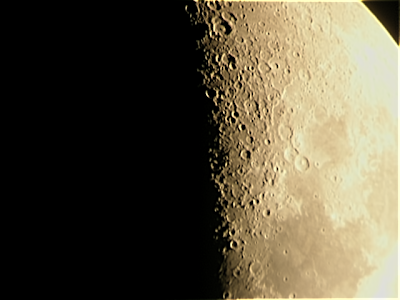
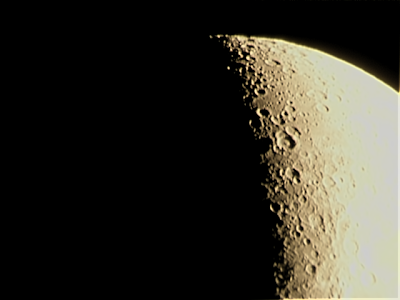

I also tried Mars again - but the results really weren't much better than before. Then the haze started to come in and I decided to go in a warm up my feet.

Despite it raining for most of the day, it suddenly cleared last night which I noticed whilst driving to the shop to stock up on a load of food items. I just knew it would have clouded over my the time I got back, but no!
The laptop was in use by its owner, so I went back to the simpler digital camera and adapter thing but on the new telescope. The moon looked great through the newer optics (it had been "new" when I first got this telescope). It was interesting to watch the heat haze and atmospheric ripples despite how cold my feet were feeling. It shows up quite well in this clip, and you can hear the wind too occasionally.
I got some reasonable pictures from this after a bit of stacking.



I also tried Mars again - but the results really weren't much better than before. Then the haze started to come in and I decided to go in a warm up my feet.
Saturday 12 January 2008
Venus in the morning
Last night was pouring rain, but waking early this morning I had a quick look outside the window and I could see stars, so I decided to get up at about 6:30am with the first faint glow of the sun starting to appear on the horizon.
The sky was clear enough to auto-align the telescope and it picked out a couple of bright stars I could see. It was still quite a way off on them though requiring some more calibration.
I could see Venus behind a tree, and couldn't work out if it was rising or setting. Anyway, I got the telescope onto it, and could finally see it as it came out from behind a tree branch.
I switched to the camera and tried to get it focused. The software focusing guide still doesn't seem to work on the software I have so its a lot of trial and error.
Eventually I got some pictures though.
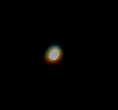
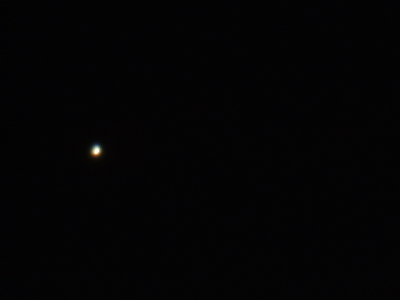
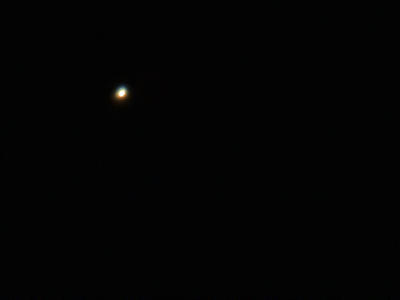
They still weren't what I was hoping for, as focusing is really tricky. I'm hoping the flexible focusing knob I ordered will help with this when it comes.
The sky was clear enough to auto-align the telescope and it picked out a couple of bright stars I could see. It was still quite a way off on them though requiring some more calibration.
I could see Venus behind a tree, and couldn't work out if it was rising or setting. Anyway, I got the telescope onto it, and could finally see it as it came out from behind a tree branch.
I switched to the camera and tried to get it focused. The software focusing guide still doesn't seem to work on the software I have so its a lot of trial and error.
Eventually I got some pictures though.



They still weren't what I was hoping for, as focusing is really tricky. I'm hoping the flexible focusing knob I ordered will help with this when it comes.
Thursday 10 January 2008
A frustrating evening
I got home to relatively clear skies. My the time I'd had tea, got the children into bed and so on, the sky had cloudy over completely. Then it started to clear and I could see Mars and bits of Orion. I got out the telescope but there was only the odd star visible at a time as clouds drifted passed, so not enough to try aligning it.
Then it clouded over again. About an hour later it was starting to clear in patches again and I could clearly see Orion, so I got out the laptop and the camera attachment.
By the time I had things assembled the cloud had drifted in again and covered it up. Half an hour later when I looked out it was starting to clear a bit again, and for a time it was clear enough to pick some stars for alignment. Then with Mars in the frame I took some images, but they weren't great - there seems to have been a fair bit of high level thin cloud. I think its also overexposing.
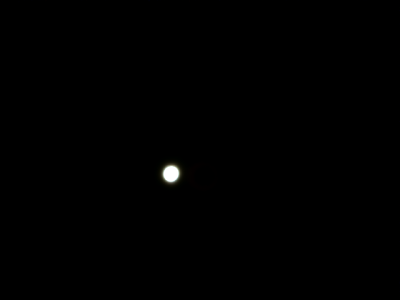
It did give me a chance to try it with a 2x barlow lens which looked promising. I also managed to try out Saturn again, but I couldn't really get the focusing right, and it kept drifting in and out of the haze.

So after several hours in the will it, won't it clear mode, I decided to give up and go to bed!
Then it clouded over again. About an hour later it was starting to clear in patches again and I could clearly see Orion, so I got out the laptop and the camera attachment.
By the time I had things assembled the cloud had drifted in again and covered it up. Half an hour later when I looked out it was starting to clear a bit again, and for a time it was clear enough to pick some stars for alignment. Then with Mars in the frame I took some images, but they weren't great - there seems to have been a fair bit of high level thin cloud. I think its also overexposing.

It did give me a chance to try it with a 2x barlow lens which looked promising. I also managed to try out Saturn again, but I couldn't really get the focusing right, and it kept drifting in and out of the haze.

So after several hours in the will it, won't it clear mode, I decided to give up and go to bed!
Tuesday 8 January 2008
My first guided telescope.
So with Christmas over, and no telescope found under the tree, I decided its time to buy something more serious. Like a number of hobbies, you can spend an inordinate amount of money on equipment without trying really. In the end I opt to buy a Meade ETX 125 PE. This is partly because it currently has an offer which includes a number of additional lenses and filters which adds considerably to the value. It has on it a list of things I wanted which includes
- A GOTO system - after alignment you can tell it to go and locate a given star or planet.
- A computer interface allowing possible remote control of the telescope from a PC.
- A reasonable diameter mirror (127mm/5inch).
- The pack of eyepieces, which range from 40mm (47x mag) to 6.4mm (297x). There is also a barlow lens which allows the doubling of all above magnification.
- A built in equatorial wedge - this allow the telescope to track in a plane the same as the stars rotate in - so only one direction of track required. Normally it works in Alt-Az mode - which means it has two motors one that moves it around in a circle, and the other is up and down.
Wonder of wonders, after I get home and play with my new toy in the daylight, the skies clear as it gets dark and I can try it for real.
I tried just looking through it initially, and it was a lot clearer. Then I tried aligning it in auto mode. This is very clever, although it takes 2-3 minutes, which if like me you have to do a few times gets boring quickly. First it finds north, then it works out what the tilt and inclination is, and then it selects where it thinks two stars are it can align with. Well the first star it picked I had no idea - it could have been one of several. I found out later pressing the ? button tells you what star it is thinking it should be, and with stellarium running nearby, this helps a lot. I also found you can skip stars that might not be visible. It is rather sensitive to being interrupted while slewing though. Also realigning without power cycling seems to give rather odd results.
Also so far, the alignment isn't very exact, by picking two widely separated stars it seems to improve. You end up somewhere nearby what you're interested in, but its not always even in the field of view. I'll have to recheck I have input all the correct details.
Mars when viewed was a lot clearer, as were some other things I looked at. After that I spent a while installing the camera software and working out how to get that to go. Then I tried some imaging. This required the laptop close by so the USB cable would reach, and a bit of experimentation.
The results were not too bad, but not as good as I'd hoped - but all this was within a few hours of getting the kit out of the box, and learning how everything worked from scratch. So I guess I should carry on and see what can be done.
Mars was still readily accessible.

Saturn rose - but due to the location I'd picked it rose in between the branches of a tree, and there was intermittent cloud cover, so I was lucky to get anything.
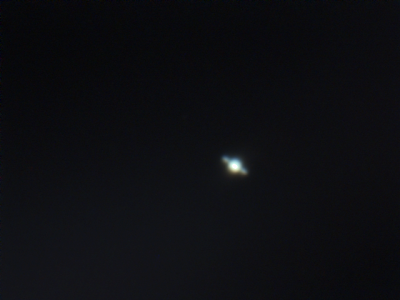
I tried a deep sky object too - the Orion nebula in this case.
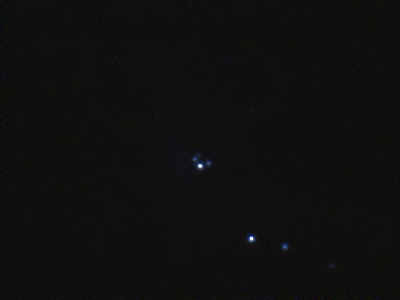
Not bad I suppose altogether for day 1.
Subscribe to:
Posts (Atom)



